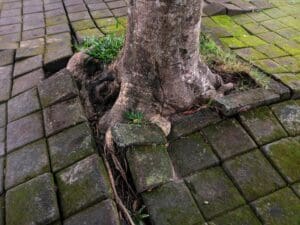- Tree roots can spread far from the tree in search of water, often growing toward a home’s foundation.
- Roots can displace soil, causing foundation cracks, shifts, and other structural issues.
- Signs of root damage include cracks in walls, uneven floors, and visible roots near the foundation.
- Preventive measures include choosing appropriate tree species, planting at a safe distance, and installing root barriers.
- Regular foundation inspections can help detect root-related issues early and prevent costly damage.
Trees are beautiful and valuable additions to a property, but their roots can pose a significant threat to the health of a home’s foundation. Understanding how tree roots grow and impact foundations is crucial for homeowners with trees near their property. If not properly managed, tree roots can cause extensive damage to the integrity of a home’s structure.
How Tree Roots Grow
Tree roots are naturally designed to spread out in search of water and nutrients, often extending far beyond the visible canopy of the tree. A common misconception is that tree roots grow deep underground; in reality, most roots remain in the top few feet of soil where water and nutrients are most abundant. Depending on the tree species and local soil conditions, roots can spread out as far as two to three times the height of the tree.
Roots grow outward in all directions, but they are particularly drawn to areas where moisture is present. This is why they often migrate toward a home’s foundation, especially in periods of drought when the soil around the house may hold more moisture than the surrounding soil.
How Tree Roots Can Damage Your Foundation
As the tree grows, its roots can displace soil, creating voids or causing soil to shift. When the soil around a foundation is moved or displaced, it can lead to uneven pressure on the foundation, resulting in cracks, shifting, or settling.
In some cases, roots may grow directly into foundation walls, especially if there are small cracks or gaps. Over time, the pressure from growing roots can exacerbate existing foundation issues, leading to further structural damage. Even if roots do not directly penetrate the foundation, they can create pressure against foundation walls, leading to bowing or warping.
Warning Signs of Foundation Damage from Tree Roots
Homeowners should be aware of several signs that tree roots may be affecting their foundation. Some of the most common symptoms include:
- Cracks in Walls or Floors: As the foundation shifts or settles due to root activity, cracks may appear in the walls or floors of the home. These cracks may start small but can grow over time as the foundation continues to move.
- Uneven Floors: Tree roots can cause the foundation to shift, leading to uneven or sloping floors. Homeowners may notice that furniture no longer sits level or that doors and windows become misaligned.
- Tilting or Leaning Structures: In severe cases, tree roots can cause significant shifts in the foundation, leading to tilting or leaning of parts of the home.
- Visible Roots Near the Foundation: If tree roots are visible near the foundation or begin to push up through the ground, it could be a sign that they are impacting the foundation.
- Landscape Changes: Changes in the landscape, such as sudden dips or mounds in the ground near the home, can also be a sign of root activity affecting the foundation.
Preventing Tree Root Damage to Your Foundation
While tree roots can be a significant threat to foundations, there are steps homeowners can take to minimize the risk of damage.
- Choose Appropriate Tree Species: When planting new trees, choose species with less aggressive root systems. Consult with a local arborist or landscaping professional to determine which trees are best suited for planting near homes.
- Proper Planting Locations: Ensure trees are planted at a safe distance from the foundation. A good rule of thumb is to plant trees at least as far away from the house as their expected mature height.
- Install Root Barriers: Installing root barriers can help prevent roots from growing toward the foundation. These barriers are typically installed underground and redirect root growth away from the home.
Warning Signs of Foundation Damage from Tree Roots
It’s essential to recognize early signs that tree roots may be affecting your foundation. Addressing these issues promptly can prevent them from escalating into more severe problems:
- Cracks in Walls or Floors: Small cracks may appear in your home’s interior or exterior walls, ceilings, or flooring. These cracks can widen if the underlying issue isn’t resolved.
- Uneven or Sloping Floors: Shifting foundations can cause floors to become uneven or slope, making furniture appear tilted and doors or windows misaligned.
- Sticking Doors and Windows: Difficulty opening or closing doors and windows may indicate structural shifts due to foundation movement.
- Visible Roots Near the Foundation: Large roots emerging near the foundation are a clear sign that they may be impacting your home’s structure.
- Changes in Landscape Topography: Sudden dips, mounds, or cracks in your yard near the house can signal root activity affecting the soil structure.”
Protecting Your Home’s Foundation from Tree Roots
Tree roots can have a significant impact on the health of a home’s foundation, potentially leading to cracks, shifts, and other structural issues. Homeowners should be proactive in managing tree growth near their homes by choosing appropriate tree species, ensuring proper planting locations, and taking preventative measures like installing root barriers. Regular inspections and maintenance can help protect the foundation from root damage and ensure the long-term stability of the home. If you suspect that tree roots are affecting your foundation, contact Advanced Foundation Repair for a professional assessment.

